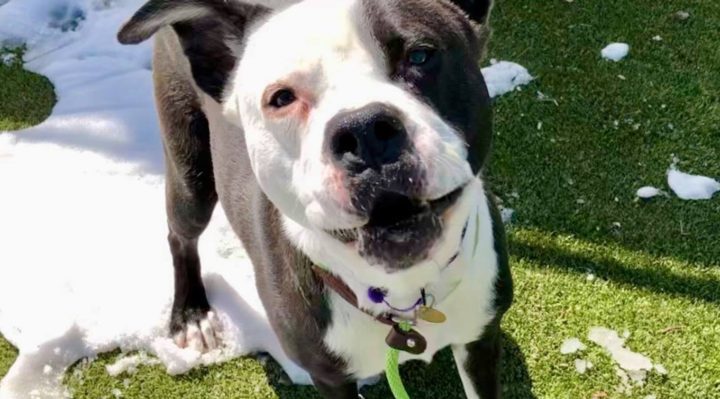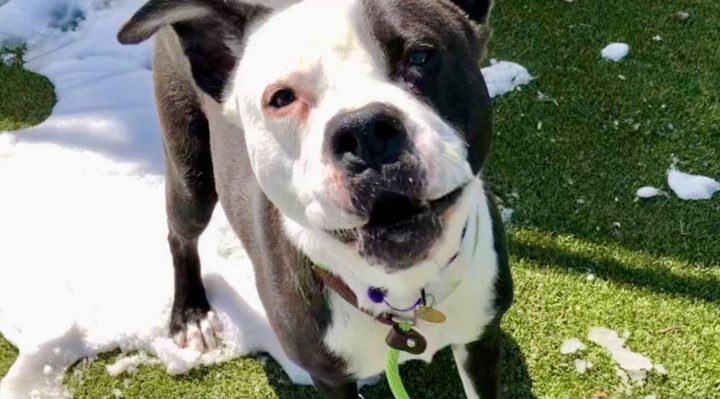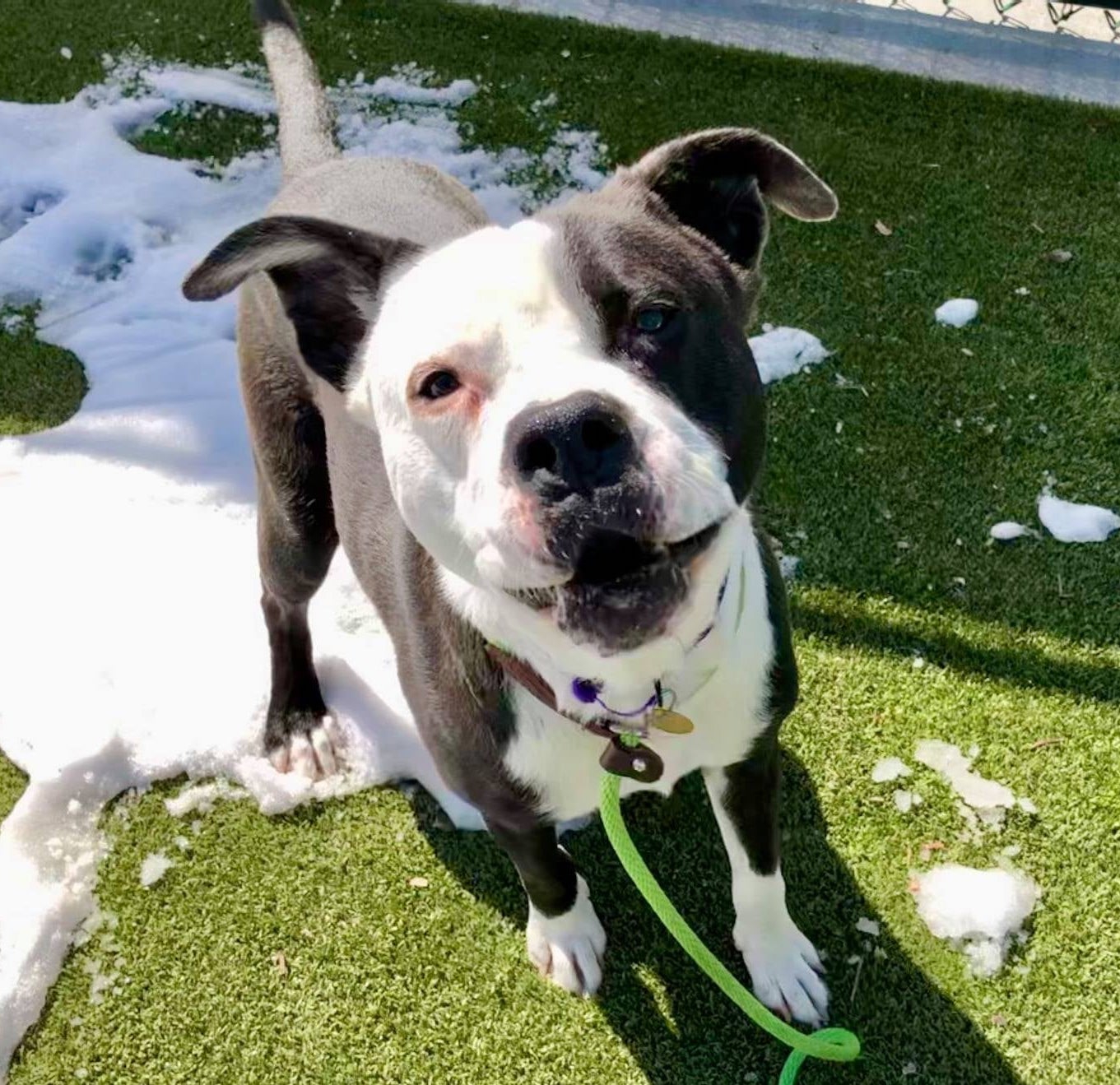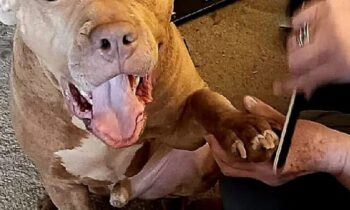

You’re walking your dog on leash, as the law where you live requires, and suddenly, a loose dog is running toward you, fast—intention unknown.
What do you do?
I asked dog professionals online for suggestions on dealing with unleashed dogs when your dog is on leash. They responded with advice that may sound harsh to you—unless you’ve never had a bad experience with the approach of an unleashed dog. Once it’s happened to you, you might reconsider.
What works?
Jill Gibbs (Montana) When I see any dog coming towards me on my walk, I pull my dog/s over to the side of the walking path (which is fenced), putting the dogs between me and the fence. I put them into a sit for the other dog/s to pass. Most people realize I don’t care to have their dogs near mine, but when a moron doesn’t read my signs of “Leave us alone,” I will tell them to call their dog. Typically, I get, “Oh, my dog is friendly.” I tell them my dog will hump theirs. The look on their faces is so worth it. Problem fixed. I do carry pepper spray, but I would probably use it on the owner instead of the dog, since it is their fault, not the dog’s.
Debby McMullen (Pennsylvania) I carry Spray Shield (by Petsafe) and always have it ready when I am out anywhere that a loose dog might happen. [If you don’t have] Spray Shield on you, short-leash your own dog, nudge them behind you, and swing your leash like a lasso in front of you. This is one of the things we taught in dog-handling class at the shelter where I started my career. Shouting forcefully to “go away” actually does work if you put the right energy into it and the dog isn’t aggressive. I am also always mindful of where there might be any raised surface that I can quickly get my dogs on to better defend them. I tell people to put their dog on a leash and I raise my phone to take pictures to encourage them.
I see some people mentioning that you should drop your dog’s leash to not hinder their flight. I’m not allowing my dog to get into a fight. It is my job to protect them. I will not be dropping their leash and I will be inserting myself between the loose dog and them. Your dog needs to know that you can protect them. Don’t let them fend for themselves.
Jo Jacques (Massachusetts) Water guns. Super Soaker. Go for the owner if they don’t get the dog on the leash. Seriously, though, I got to the point where I started telling people that my dog had some sort of communicable disease that their dog would catch. And it required very expensive medical treatment.
Stacy Braslau-Schneck (California) “It’s OK, my dog’s friendly!” they say. Your answer? “Well, my dog’s contagious!”
Alisha Ardiana (California) I have learned that the public does not care if my dog is fearful, reactive, injured, recovering from surgery. Nothing I say seems to work.
However, I once was training a dog with an eye infection. It was amazing how many people kept their dogs away because I stated loudly, “Stay back!! He’s contagious and he can give it to your dog.”
By having my dog on a leash, I am indicating that I am trying to protect the public. This also enables me to channel my true emotions, and it actually makes me look like a concerned citizen, versus a crazy person.
I once was training a French bulldog that needed to be kept away from the public. A woman with kids wanted to meet him. I scrunched up my nose and said “Ma’am, he’s got ringworm. You don’t want that.”
A final example—an older gentleman really wanted to meet a dog that I walked. I knew the dog did not want to be petted. I ended up telling the man that the dog is a carrier of MRSA, and that he would infect him.
Dogs deserve access to public space with anonymity.
I have also learned it that does not matter if my dog is reactive or not. Merely by telling the public that we don’t want to meet their dog often puts them in a state of indignation. (It’s in the cultural fog that all dogs need to meet each other.) And then I think there’s also some shame when they are unable to get their dog away from us.
I personally try to interact with these strangers as little as possible. The amount of energy I can put into it is not healthy.
I also recommend walking on the edges of parks, where there are streets with cars. The best way for me to avoid an off-leash dog is to head for the street. That’s often the only recourse that will make the owner gather their dog.
Here’s the video I share with clients:
Training Bytes: Avoiding Dogs | empawthy

Photo by Steven Cogswell
Marilyn Marks (Connecticut) When I have to deal with this, I choose a mean and rude personality. Never raging, but anywhere from indignant to angry. Why? Because it creates boundaries and immediate action, which is what’s needed for things to turn out well. I want the person and dog to know they’re impinging on my space. I use body blocking if the dog comes close. If the dog is threatening to me or my dog, I will bodily move it (moving toward to get it away, saying “go” in a deep voice) and owners get mad.
If it’s a true threat—attacking—I would carry mace or pepper spray. I have not needed this, but some of my clients live in areas where it’s a common thing. Plus people get way more bent out of shape when you spray than when you just become socially problematic. My behavior differs based on who’s on the leash and who’s rushing us, something pet owners may not be able to assess—though with professional guidance, yes [they can learn].
Rebekah Piedad (California) Pop-up umbrella.
Evee Linden (Connecticut) Bear spray. One of my clients had to use it just the other day; the intent behind the dog I would judge was mid-level serious. The owner chased after them with their dog on a leash, my client warned him, he kept chasing after them, so she sprayed them. It stopped the dog dead in his tracks. Sadly enough, the spray didn’t reach the owner. If a dog is truly intent on mauling, I am not sure what would stop it.
Olwen Turns (United Kingdom) Umbrella.
Jim Mihalek (Minnesota) I used to carry a spray when I walked my dogs in town. I carried a large metal flashlight, too, to use when finding their poop in the dark. It was also a good weapon against loose dogs, coyotes, and people if needed . . . to the point that I carried it during the day, too.
James Stripes (Washington) I carry pepper spray. I would prefer to spray the owner, but have sprayed dogs that were too close and advancing. Better to be sprayed than to be torn apart by my boxers.
Ann Watt (United Kingdom) Pop-up umbrella.
Jeanne Brennan (California) First thing I do is get my dog behind me.
Second thing I do, which is most often a fail, is to yell at the owner to get their dog. It commonly fails because I have never yet had an owner respond by quickly moving to their dog to grab it or get it under control. Never, not once, have I seen an owner immediately take action.
What have I done? Depending on the dog’s approach and the time I have to respond, I have done all of the following:
● I have yelled to “go home” while throwing my arm out to point. Once, after repeated yelling at one owner whose small dog was running full-speed and growling at my 40-pound reactive dog, I yelled, “You need to grab your dog before mine picks it up and shakes it!” That made her hang up her phone and come get her dog and the retractable leash that had popped out of her hand.
(I wasn’t actually yelling. I was talking loudly, using authoritative language, while controlling my breathing—so I’m sure I came off as a little weird. My dog was actually not being reactive, though her body had stiffened with a flagged tail. I know humans yelling and appearing reactive just triggers reactivity in their dogs, but this dog paid very close attention to my breathing. It’s funny to be using angry words but trying to use a tone that sounds like you’re telling kids at a party that the cake and ice cream is being served.)
● I have thrown a ball at and past the dog to distract it, hoping it chases the ball.
● I have thrown treats (handful) at the dog’s head and off to the side.
● I have carried a pop-out umbrella but have not had need to use it yet—though I have practiced with it. The idea being that a quick pop-out can startle and distract the oncoming dog, then act as a shield. Yes, a dog could shred an umbrella if they were to get hold of it. The thing is, dogs move around things they see as obstacles; that is what they do. It is important to play with the pop-out umbrella around your own dog as you do want them desensitized to it.
● I carry a gel pepper spray that streams (versus an aerosol that sprays in a cone and more easily drifts), and I test it by aiming and spraying before each walk, but I have never needed to use it on a dog. Honestly, I feel like I’m not quick enough to grab it.
● I have done some leash swinging, like whipping, at the dog if it gets that close, because I always have an extra leash (training and working at a shelter—it’s habit).
Should everything fail, should teeth connect with another dog (and it could be your dog that connects), grab the REAR LEGS!
Sadly, I’m too skilled at going in to break up fights, so I don’t hesitate. I have yelled at owners to grab their dog’s rear legs, but they are usually too stunned to move.
Frances Dauster (Alabama) I’ve given up on “nice” suggestions—I reached the end of my rope with all the “training my dog to accept being attacked” and “my dog is friendly” crap. I now recommend that people carry a walking stick (Amazon, hickory carved, 5.5 feet long, under 40 bucks) and to tell loose dogs’ owners that you’ll defend your dog.
Em E Wolf (Vermont) You can buy a taser on Amazon for like $20. It’s not a bad idea to carry in your bag as a last resort.
Christine Hale Vertucci (Illinois) I carried Spray Shield when I lived in a more densely populated neighborhood with few ways to avoid other dogs. I also once yelled “SIT” at an approaching off-leash, unattended dog, and it WORKED!
Colette Kase (Mexico) I live in a place where semi-feral street dogs and free-range dogs are common. They are very rarely much of a problem as they naturally want to avoid conflict. If you enter their territory, they may rush and bark, but they simply wish to escort you off their territory. Once you hit what they consider their boundary, they retreat.
The dogs that are a problem are owned dogs who have escaped a fence, gate, or wall. They are usually the most aggressive.
Then there is the world-wide problem of irresponsible owners walking their dogs off-lead.
The city that I live in has a lead ordinance, which means there are no parks or beaches where you are allowed to walk your dog off-lead. That doesn’t mean it doesn’t happen.
The best way I’ve found to deal with off-lead dogs when my dog is on-lead is to avoid conflict with any dogs. To avoid conflict with any dogs, I start by knowing my route, or the location of my walk. I know if it is frequented by free-ranging or stray dogs, and I know which houses have aggressive dogs behind fences. If I’m walking in a popular location, I opt for unpopular times. Interestingly, you’ll find that most dog-walkers who are trying to avoid irresponsible owners are also walking at this time, so you can all keep your space and no one will be offended.
My dog has been trained to allow me to go first when we reach a corner and wait while I look around the corner to see if everything is clear. If I see a dog without someone attached to it, I will immediately go back in the other direction decisively. Even if we have been seen, most dogs are very responsive to body language like that. On the odd occasion, we’ve been trailed by an over-enthusiastic sniffer, but they veer off eventually if you keep your pace up.
While I’m walking, I always stay on high alert. I look around for low walls and gates without dogs behind them that I could jump over with my dog to provide us both with a barrier between us and an aggressive dog. My dog is 40 kilos, but I could throw him over a low wall in an emergency.
One other trick is to walk on busy roads. You encounter very few off-lead dogs when you do.
Micha Michlewicz (Maryland) First approach is to train your dog to get and stay behind you as you move to shield them. You can try throwing treats or yelling at the approaching dog. An extra slip leash can be helpful if you can use it.
If someone tells me that their dog is friendly, I tell them that mine isn’t!
Second is an umbrella—with training [for your dog] to move and stay behind it so you can shield them. It can also be used to scare off some dogs.
Last is back-up pepper spray. (I don’t trust electronic tools in case they only make the dog more aggressive.) Pepper spray will disable vision and scent.
Xan Latta (Montana) I use super-light slip leads and almost always have an extra in my pocket since they come in handy for all manner of things. I can leash another dog and drop leashes on my own if need be. And if a biting dog is clamped down on another (or me), I can better control their head and choke them out—not pretty, but it gets the job done when they’re in that “I’m never letting go” zone.
Kat Camplin (California) Food toss. Keep moving. Find an escape location if needed. I had three dogs on-leash and was charged by four dogs off-leash. I threw mine in the bed of a nearby pickup truck. I’ve thrown a small dog in an empty trash can.
Timothy Page (Oregon) I was in Central Washington with a co-worker and we stopped to eat at a restaurant in Ellensburg. I wanted to walk Chiquis (12-pound chihuahua) to the grassy area first. As we were approaching the car to put her back in, I heard a man yell: “PICK UP YOUR DOG!” I turned and saw a huge angry-faced dog coming for Chiquis. No time to do anything but swing her up into the air on her leash. I’m sure that big dog would have otherwise crushed her in one bite. I’m not a fan of swinging dogs on a leash, but it was an instant instinct that saved her life. The man had opened his SUV to take out his dog, but when it saw Chiquis, it zipped right by him. The man apologized and I soothed Chiquis, who was pretty terrified, I am sure. I have had to pick up my dogs on many occasions.
Jessica Stinson Hudson (Alabama) You couldn’t print my suggestions. Still traumatized by defending my dog several years ago from a dog with intent, dragging a huge rope, and off his property with his meth-head owners running behind him. I’ll do whatever is necessary and I’m sick of encountering loose dogs while working with clients.
Teresa Tuttle (Texas) Carry an umbrella.
Danette Benton (Florida) I have a hiking pole with a taser. Amazon.
Lynn Brezina (Illinois) Avoid. My walk routes are planned around areas where I am least likely to find off-leash dogs. Otherwise, all bets are off.
If you spray something and you are downwind, you and your dog get the spray. If you make some kind of loud noise, you could traumatize your own dog.
I like to keep a bag of treats that is not easy to open, to toss in the direction of the loose dog. But that requires your aim to be good and the dog to be interested.
Jessica Theisen de Gonzalez (New York) Unleashed dogs are a huge problem in my neighborhood. My dog is okay with all dogs but—in a rather startling turn of events!—many off-leash dogs are not dog-friendly. I scan the street constantly. If we are approaching an unknown dog, I start watching for body-language cues and the “handler’s” ability to cope with behavior changes, if any. Some people will shrug and sigh while re-leashing their dogs. At a minimum, we cross the street. If [the other dog] is very agitated, I try to signal which direction I’m headed in and backtrack. I also know which buildings have front doors that don’t lock, or doormen; and stores we could duck into. I have zero desire to go up against any handler who is flouting city ordinances with a challenging off-leash dog. I’d rather totally change our course than risk an incident.
Lori Katz (California) Gel mace.
Sally Foote DVM (Illinois) Carry an umbrella. Pop it open to use as a shield.
Jackie Pritchard (Ontario) The older of my two dogs has been repeatedly harassed or attacked by the same dogs over and over again. I am simply trying to go for a nice walk through my community, which is in the country. My dogs are both rescues and we’ve all worked long and hard to overcome many issues, both health-related and behavioral. Both my boys are very good boys and I am exceptionally proud of them.
I cannot possibly carry my weapon of choice, which is my walking stick. I walk my two boys on-leash until we get to the trailhead, where my shepherd is allowed to be off-leash. My husky mix has not yet earned his off-leash privileges because he has a very high prey drive. At the trailhead, he is switched over to a 50-foot long-line.
I use my voice, my body language, and my skills as a trainer to protect my dogs and keep them safe. I would protect my boys with my life and they would do the same for me.
I have approached the people responsible for having their unleashed dogs attack mine on a public road—told them in no uncertain terms that if this happens one more time, I will be filing a formal complaint and they will be charged. It has not happened again since the last incidents. We shall see what the summer brings . . .
Tamara A Howard (New Jersey)
● Tasers shoot live cartridges, usually at a 15-foot distance. Target practice will help your aim in stressful situations.
● Stun guns are body-contact only.
Know your local laws before carrying or using either.
● Pepper gel is far better than pepper spray due to less blowback and dispersement.
● Spray Shield (Citronella spray) works and does double-duty by repelling annoying flies and mosquitoes!
My dogs are trained from puppyhood to get behind me. I protect them, not the other way around. It’s a shame any dog has to pay the price for its owner’s ignorance. However, if it’s my dog or yours, there’s no choice to be made.
Claudia Black-Kalinsky (Georgia) If the dog is approaching stiff and snarky . . .
● Don’t “be a lady.” Get LOUD. Scream “Go home!” while the dog is 25 feet away.
● Yell “FIND IT!” while tossing treats directly at the dog as they get within treat-tossing range.
● Spray Shield if they get closer.
● Scream for help.
● More Spray Shield. Poke them with a stick or kick if you can safely.
*** Never put your hands in a dog fight. ***
● Call animal control and/or the police and report the incident when it is over.
Practice is the most important part of a plan to deal with unleashed dogs when your dog is on-leash and walking with you. First and foremost, take the time to acclimate your dog to any action you plan to take. For example, if you intend to “pop” open an umbrella in the hope it will deter the advance of an unleashed dog, start with the smallest possible steps toward acclimating your dog to the sight and smell of the umbrella—unmoving, closed, on the floor or ground. Give your dog a chance to investigate . . . that’s all. Next step? Same deal, different location. Repeat until the dog is “used to” the umbrella as a safe part of the scenery. Eventually, use same set-up with the umbrella only very slightly opened—still on the ground or floor, unmoving (put it there when the dog is not present). Etc.
Yes, acclimating the dog all the way to the “pop” could be a time-consuming process.
Be patient.
The other choice—not to acclimate the dog to the deterrent—will most likely result in your dog’s reaction to your first attempted use of the deterrent (a reaction that may well be fear) making the confrontation with the unleashed dog even more dangerous for both of you.
Practice using deterrents without your dog.
Set your dog and yourself up for success!



